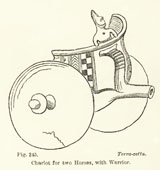Previous First Next
SALAMIS IN THE ISLAND OF CYPRUS.
BY ALEXANDER PALMA DI CESNOLÀ, F.S.A.,
page 111
the door, by means of which the riders ascended to their places. The riders are shewn to be the warrior in a high conical helmet, the cover of which, painted black, falls about the shoulders like the camail of a mediǽval or oriental warrior. Thelappels, like the ]aces of a modern helmet, fall by the sides of the face, and are united in front of the breast by a brooch, or stud. A band, or coronet, which extends across the forehead, comprises rosettes at its extremities, and a single rosette in the centre. The hinder part of the head-covering falls, like that of a hood, on the neck. The loose body-coat of this champion is now of a pinkish orange, or broAvn; it was, probably, originally black. A baldric of crimson crosses two belts on the body. The face is painted, to imitate nature, with a brownish carnation. The arms of this figure comprised a shield, on the surface of which are a large central boss and seven spirals, ending in as many studs, arranged about it. The ground is of the same vivid red as that of the chariot wheel. Radial curved lines of black have been drawn with a brush, so as to form a pattern with the boss and studs, which are likewise painted black. In his right hand is a weapon—a sword, or lance—which has disappeared. Squatting low between the knees of the fighting man is the other figure, the driver of the chariot, with his arms extended as if holding the reins and guiding the horses. His black face and the forms of his features indicate that he is a negro. He wears a high, peaked cap of very brilliant red. This very extraordinary specimen of archaic type was found at Salamis in a vase of terra-cotta, and bedded in lime, to which circumstance the brilliancy of the red colour may be due, as well as the perfect preservation of the relic. Traces of the lime are still distinct on the surface of the group. There is another chariot, likewise found at Salamis, in the form of a flat tray mounted on wheels, which still turn on the axletree, so that this a "practicable" toy. In the front of the tray a  cylindrical socket occurs, with a hole, into which, probably, a stick was driven, in order that the child-owner might dragthe vehicle after his own footsteps. In the tray reclines a lady, with one elbow sustained by a cushion; the cushion isstillred. This colour was burnt in, and is, therefore, permanent. This lady's head is decorated with a large garland; a large disk-like ear-ring is attached at each side of the head; the open mouth is of a deep red. Traces of a similar colour are on the robe of the lady and the chariot. On the robe are more traces of bright yellow. Another biga or two-horse chariot (fig. 245), of which the wheels are still in perfect order, is adorned with a band of chequered, and a band of chevroned pattern, on each side. The front is semicircular, and has a socket, into which the pole was fastened before the two cylindrical socket occurs, with a hole, into which, probably, a stick was driven, in order that the child-owner might dragthe vehicle after his own footsteps. In the tray reclines a lady, with one elbow sustained by a cushion; the cushion isstillred. This colour was burnt in, and is, therefore, permanent. This lady's head is decorated with a large garland; a large disk-like ear-ring is attached at each side of the head; the open mouth is of a deep red. Traces of a similar colour are on the robe of the lady and the chariot. On the robe are more traces of bright yellow. Another biga or two-horse chariot (fig. 245), of which the wheels are still in perfect order, is adorned with a band of chequered, and a band of chevroned pattern, on each side. The front is semicircular, and has a socket, into which the pole was fastened before the two
Previous First Next
|